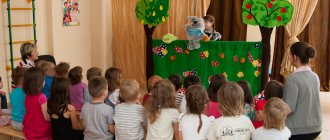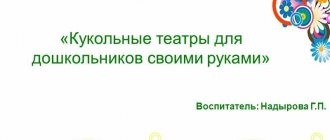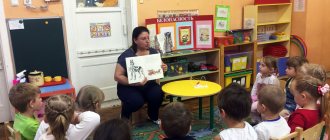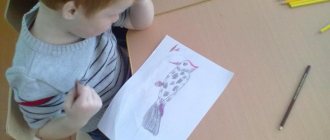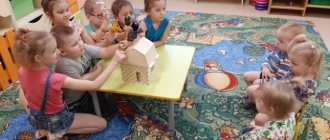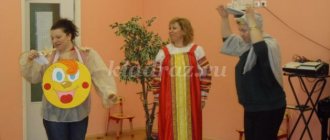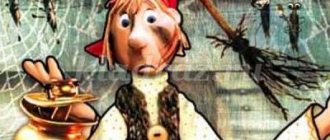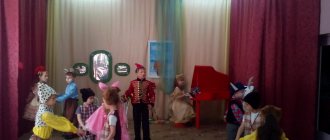Goals and objectives of theatrical activities in the middle group
Theatricalization is considered as a means of developing speech activity, communicative, and artistic abilities of children in the middle group. As a rule, middle preschool age is a wonderful time to develop the creative talents of young children.
Goals and objectives of theatrical activities for students in the middle group
Already in the fifth year of life, preschoolers happily try on various roles of their favorite characters. They are impressed by fictional images (characters from cartoons, fairy tales). Over time, the children become more relaxed and understand the nature of human relationships.
Note! Each theatrical activity lesson is aimed at solving many problems that harmoniously develop a child aged 4-5 years.
Educational objectives according to the Federal State Educational Standard:
- Initially, the children are introduced to theatrical terminology. The children study varieties of theatrical art. They should have an idea of how to behave properly while in the theater.
- The conditions of theatrical play are focused on the stage space. Preschoolers learn how to move around the playground correctly. They also build dialogue with their peers. Setting up a specific topic requires special effort. Children must remember all the words and sentences of their favorite characters from a theatrical sketch.
- How the work on the performance is carried out. As early as the fourth year, children are taught to develop manipulative skills using imaginary objects. To embody specific feelings and experiences in a performance, you will initially have to create a certain image. Intonation, facial expressions and pantomime are especially helpful.
- Rhythmoplasty plays an important role. This is a kind of reaction to a musical signal or command. While performing the action, the guys must act in concert, remember various poses and convey them figuratively.
- It is necessary to develop speech culture. Preschoolers aged 4-5 years develop correct articulation and clear diction. The teacher must develop the ability to change intonation, compose short stories and fairy tales, and find elementary rhymes.
The preparatory development process considers the following tasks:
- Analysis of theatrical performance, which instills public speaking skills.
- The vocabulary is activated and the vocabulary is enriched. In order to clearly pronounce all the sentences in a theatrical sketch, it is necessary to improve the intonation structure and develop dialogic speech.
How to prepare for a performance and how a lesson is conducted at a preschool educational institution
You should also pay attention to educational tasks:
- Improving the general culture of preschoolers, introducing them to spiritual values.
- Theatrical activities contribute to the development of independence, artistry, and creativity. During the lesson, the child learns to communicate with his peers.
Note! The main goal is to introduce children to the magical world of theater. To do this, the teacher must prepare interesting theatrical performances. While completing all these tasks, children should know what the auditorium, orchestra pit, stage and other important details are.
The main tasks of theatrical activities in different age groups of preschool educational institutions
The main tasks of theatrical activities in different age groups of preschool educational institutions
Each of us spends our childhood in the world of role-playing games.
which help the child master the rules and laws of adults.
Each child plays in his own way, but in their games they all copy adults, their favorite heroes, and try to be like them. Children's games can be considered as improvised theatrical performances. The child is given the opportunity to play the role of an actor, director, decorator, prop maker, and musician. Making props, scenery, and costumes provides an opportunity for children’s visual and technical creativity
. Children draw, sculpt, sew, and all these activities acquire meaning and purpose as part of a common plan that excites children.
Particular importance in children's educational institutions can and should be given to theatrical activities
, all types of children's theater, because they help:
· form the correct model of behavior in the modern world;
· improve the child’s general culture and introduce him to spiritual values;
· introduce him to children's literature, music, fine arts, rules of etiquette, rituals, traditions, instill a sustainable interest;
· improve the skill of embodying certain experiences in the game, encouraging the creation of new images, encouraging thinking.
In addition, theatrical activity is a source of development of feelings and deep experiences of the child, i.e. it develops the child’s emotional sphere, forcing him to sympathize with the characters and empathize with the events being played out. The shortest path to emotional liberation of a child, removal of constriction, learning to feel and artistic imagination is the path through play, fantasy, and writing.
The improvement of speech is also closely related to theatrical activities, since in the process of working on the expressiveness of characters’ remarks and their own statements, the child’s vocabulary is imperceptibly activated, the sound culture of his speech and its intonation structure are improved.
Theatrical activities include acting out fairy tales, skits, role-playing dialogues based on illustrations, independent improvisations on topics taken from life (a funny incident, an interesting event, etc.); watching puppet shows and talking about them; dramatization games; acting out fairy tales and dramatizations; exercises to develop expressiveness of performance (verbal and non-verbal); exercises for the social and emotional development of children.
A huge role in organizing theatrical activities is played by the teacher, who skillfully guides this process. It is necessary that the teacher not only read or tell something expressively, be able to look and see, listen and hear, but also be ready for any “transformation”, that is, master the basics of acting, as well as the basics of directing skills. This is what leads to an increase in his creative potential and helps to improve the theatrical activities of children. The teacher must strictly ensure that with his acting activity and looseness he does not suppress a timid child and does not turn him only into a spectator. We must not allow children to be afraid to go “on stage” or to be afraid of making mistakes. It is unacceptable to divide into “artists” and “spectators,” that is, those who constantly perform and those who constantly stay to watch others “play.”
In the process of implementing a set of classes
The following tasks are solved for theatrical activities:
-development of creative abilities and creative independence of a preschooler;
— nurturing interest in various types of creative activities;
— mastering improvisational skills;
– development of all components, functions and forms of speech activity
— improvement of cognitive processes.
The basis of theatrical classes is theatrical play. Basic requirements for organizing theatrical games in kindergarten:
Ø Content and variety of topics.
Ø The constant, daily inclusion of theatrical games is a form of the pedagogical process, which makes them just as necessary for children as role-playing games.
Ø Maximum activity of children at the stages of preparation and conduct of games.
Ø Cooperation of children with each other and with adults at all stages of organizing a theatrical game.
The system of work for the development of theatrical activities is divided into three stages:
· artistic perception of literary and folklore works;
· mastering special skills for developing basic (“actor”, “director”) and additional positions (“screenwriter”, “designer”, “costume designer”);
· independent creative activity.
The pedagogical task is complicated by the synthetic nature of theatrical activity, in which perception, thinking, imagination, speech are in close relationship with each other and are manifested in different types of children's activity (speech, motor, musical, etc.).
Therefore, we can say that theatrical activity is integrative.
During theatrical games:
- children’s knowledge about the world around them expands and deepens; mental processes develop: attention, memory, perception, imagination; mental operations are stimulated; development of various analyzers occurs: visual, auditory, speech motor; vocabulary, grammatical speech, sound pronunciation, connected speech skills, melodic-intonation side of speech, tempo, expressiveness of speech are activated and improved; motor skills, coordination, smoothness, switchability, and purposefulness of movements are improved; the emotional-volitional sphere develops; behavior correction occurs; a sense of collectivism and responsibility for each other develops, and the experience of moral behavior is formed; the development of creative, search activity, and independence is stimulated; participation in theatrical games brings joy to children, arouses active interest, and captivates them.
We will reveal the tasks of working with children of different age groups.
2nd junior group
Children of this age demonstrate primary mastery of director's theatrical play.
– tabletop toy theatre, tabletop plane theatre, plane theater on flannelgraph, finger theatre. The process of mastering includes mini-productions based on the texts of folk and original poems, fairy tales, stories (“This finger is a grandfather ...”, “Tili-bom”, K. Ushinsky “Cockerel with his family”, A. Barto “Toys”, V. Suteev “Chicken and Duckling.”) The child begins to use finger theater figures in joint improvisations with an adult on given topics.
Tasks:
Ø Fostering positive moral ideals, the desire to be responsive, to correctly evaluate the actions of characters.
Ø Develop a sustainable interest in theatrical play activities.
Ø To achieve free expression of children’s emotions in gestures, facial expressions, movement, singing, and words.
Ø To achieve children's performing skills in creating an artistic image, using play, song, and dance creativity for this.
Ø Expand children’s ideas about the surrounding reality, about the past and future, about objects, customs and life, nature, etc.
Ø Let children consolidate their understanding of various types of theater - dramatization, floor theater, table theater.
Ø Enrich children's speech, achieve correct intonation and expressive speech.
Ø Encourage children to improvise on the theme of familiar fairy tales, stories, and come up with stories of their own composition.
Ø Develop children's memory, thinking, imagination, attention.
Ø Teach children to correctly evaluate themselves and their comrades.
Ø To arouse in children the desire to move, that is, to dance, and create a bright, plastic image.
Ø To foster children’s desire to “play,” that is, to act out fairy tales.
Ø Achieve the ability to use song, dance and game improvisations in independent activities.
Middle group
At this age, interest in theatrical games deepens .
Expansion of children's theatrical and gaming experience is carried out through
the development of dramatization games.
At the age of 4-5 years, the child masters different types of table theater: soft toys, wooden theater, cone theater, folk toy theater and plane figures. The riding puppet theater (without a screen, and by the end of the school year - with a screen), the spoon theater, etc. are also available to children. Children show performances based on the plots of Russian folk tales “Fox with a rolling pin”, “Zhikharka”, “Rukavichka”, “Bull” —tar barrel”, “Puff”, “Geese-swans”, etc.
Finger theater is more often used in independent activities, when a child improvises based on familiar poems and nursery rhymes, accompanying his speech with simple actions (“We lived with grandma”; S. Mikhalkov “Kittens”, 3ubkova “We shared an orange”).
Tasks
Ø Cultivate a sustainable interest in theatrical and gaming activities.
Ø Lead children to create an expressive image in sketches, dramatizations, song and dance improvisations.
Ø Expand their understanding of the objects around them. Develop the ability to identify the characteristics of objects (color, shape, size). Expand children's knowledge about the characters participating in theatrical and play activities.
Ø Replenish and activate children's vocabulary. Form intonation expressiveness of speech. To develop children's dialogical speech in the process of theatrical and play activities.
Ø To consolidate knowledge about the rules of manipulation with riding dolls.
Ø Continue to develop in children the desire to participate in dance improvisations with and without dolls.
Ø Maintain the desire to speak in front of children, parents, and kindergarten staff.
Senior group
In older preschool age, the theatrical and play experience deepens
through mastering different types of dramatization games and director's theatrical games. Along with figurative play sketches, improvisation games, and staging, older preschoolers have access to independent productions of performances, including those based on a “collage” of several literary works. For example, “A Journey through Fairy Tales”, “New Adventures of the Fairy Tales Heroes by C. Perrault”, etc. The experience of directorial play is enriched by puppets, dolls with a “living hand”, and cane dolls.
Texts for productions are becoming more complex. Russian folk tales and fables about animals (“The Fox and the Crane”, “The Hare and the Hedgehog”), works by L. Tolstoy, I. Krylov, M. Zoshchenko, N. Nosov began to be used in theatrical play.
Tasks
Ø Continue to develop a sustainable interest in theatrical and gaming activities.
Ø Improve children's performing skills in creating an artistic image, using game, song and dance improvisations for this purpose.
Ø Expand children's understanding of the surrounding reality. Improve children's ability to navigate in a group, hall, or kindergarten premises.
Ø To consolidate children’s ideas about various types of puppet theaters, to be able to distinguish between them and name them.
Ø Continue to enrich and activate children's vocabulary. Improve intonation expressiveness of speech. Develop dialogical and monologue forms of speech.
Ø To consolidate knowledge about the rules of manipulating dolls.
Ø Encourage children to improvise on the theme of familiar fairy tales, stories, and come up with their own stories individually and collectively, using dolls.
Ø Develop children's memory, thinking, imagination, attention.
Ø Foster a desire to play with theater dolls. Develop the ability to use song, dance, and game improvisations in independent activities.
Ø Support children’s desire to actively participate in holidays and entertainment, using the skills acquired in classes and in independent activities.
Preparatory group
In the preparatory group, the game material becomes even more complex. Theatrical performances include: staging of theatrical plays, children's operas, musical and rhythmic plays. Dramatization of Russian folk tales, songs, literary works; dramatization games: “The Starling and the Sparrow”, “Child Kittens”, music. E. Tilicheeva.
Tasks
Ø To improve the comprehensive development of children’s creative abilities through the means of theatrical art.
Ø Develop creative independence in creating an artistic image, using game, song, and dance improvisations for this purpose.
Ø Continue to expand children's knowledge about the surrounding reality. Deepen your understanding of objects, theatrical puppets, and scenery. Improve children's ability to navigate the premises of the kindergarten. Expand and clarify children’s ideas about the types of puppet theaters, be able to distinguish between them and name them.
Ø Continue to activate and clarify children’s vocabulary, expand their vocabulary. Improve dialogic and monologue forms of speech. Foster a culture of verbal communication. Improve the ability to compose short stories, tales from personal experience, using dolls.
Ø To consolidate knowledge about the rules of manipulating dolls.
Ø Strengthen the skills of improvising dialogues of characters in well-known fairy tales. Improve the skills of collective writing of stories from personal experience using theatrical puppets.
Ø Improve memory, attention, thinking, imagination, perception of children.
Ø To develop the creative independence of children, encouraging them to convey the mood and character of the music with the plasticity of their bodies, theatrical dolls, creating a bright dance image of the hero.
Ø Support children's initiative in individual and collective improvisations on children's musical instruments that accompany puppet shows and dramatizations.
Ø Encourage the desire to take an active part in holidays, leisure and entertainment, using improvisational skills acquired in classes and in independent activities.
Work organized in this way will contribute to the fact that theatrical play will also become a means of self-expression and self-realization of the child in various types of creativity, self-affirmation in a peer group. And the life of preschoolers in kindergarten will be enriched due to the integration of games and various types of art, which are embodied in theatrical and play activities.
Prepared
teacher second
qualification category.
Get text
Preparation and conduct of classes in preschool educational institutions
Theatrical activities in the middle group of preschool educational institutions are an exciting process for children. To attract the child's interest in this activity, you need to come up with a fun game. For example, a teacher brings with him a beautiful chest that was found on the way to kindergarten. This chest contains fairy tale characters. In order for the item to open, the guys must guess the riddle.
Communicative development of preschool children
Another scenario is choosing a fun outfit. To interest children in theatrical activities, the teacher can choose the outfit of a grandmother-storyteller (Malanya or Arina). The teacher invites preschoolers to play with her.
Lesson plan
To conduct the lesson, a special long-term plan is drawn up. The idea of different types of theater is consolidated. Techniques for working with finger theater are also reinforced. The director's approach is an examination of interesting games “The Hare Had a Garden”, “Farewell to Winter”, “Meeting Spring”, during which preschoolers develop an interest in the performing arts.
Lesson planning
Important! This helps to develop goodwill and communication skills in relationships with each other.
In addition, the teacher conducts a conversation with the children while reading a fairy tale. This stimulates emotional perception. Thus, the vocabulary is replenished. Preschoolers learn to find expressive means in facial expressions.
Stage attributes
Before conducting a lesson, the teacher must prepare stage attributes (accessories, hats, scenery), such as dolls, theatrical costumes, and makeup.
Applying Stage Attributes
Example scripts
The teacher tries on the image of a storyteller who conducts a fascinating conversation with children. The children are invited to impersonate the images of the artists - learn to convey feelings through facial expressions and gestures.
Example scripts
A special theatrical project is being created in a playful form. Children must convey specific emotions to each other. The next task is to pass a certain number of claps in a circle. You need to pronounce the phrase “Let's go, let's go to the forest for nuts.”
The storyteller tells the preschoolers that a kitten has come to visit them. Children remember cartoons and fairy tales in which this hero is present, and then pass the toy kitten to each other.
The teacher reads the poem by B. Zakhoder “Kiskino Grief” or K.I. Chukovsky “Aibolit”.
An open lesson with children on GCD - a conversation is held on the content. Some children tell it sadly, others cheerfully.
The teacher invites the children to turn into a kitten who wants to steal sausages. You need to get up from the chair, like a pussy, on your hind legs, spin around the table, inhale the fragrant smell of sausages. But then the owner comes in and the kitten runs away.
Reading a poem by L. P. Savina:
“Pussy, pussy, pussy!
Julia called the kitten.
Don't rush, wait, wait!
And she stroked it with her hand.”
The children are asked to imagine how they are stroking a cat with their hand.
It's time for the storyteller to return home. She asks the guys what they liked most about the lesson, what interesting things they learned.
MAGAZINE Preschooler.RF
Theatrical activities in the middle group - a journey into the world of creativityAuthor:
Kuzyashina Svetlana Petrovna MADOU Kindergarten No. 39 “Chamomile” Vidnoye, Moscow region.
The most popular and exciting area of gaming activity in preschool education is theatrical activity. Theater for children is a fairyland where fantasies become reality, objects come to life, and good always triumphs over evil.
Theatrical activities contribute to the development of the emotional sphere of the preschooler, teach him to sympathize with the characters and empathize with the events being played out. Theatrical activities in a preschool institution are included in the general educational process, carried out during the organization of various types of children's activities (game, communicative, musical and artistic, etc.); educational activities that are carried out during regime moments; independent activities of children.
The time for organizing and conducting theatrical activities is not regulated. It is possible to integrate it with other types of activities (music classes, work on speech development, while reading works of art and looking at plot pictures, etc.) It can also be scheduled at separate hours in the form of a circle.
The pedagogical basis for organizing the process of theatrical activity in preschool institutions is the peculiarity of the perception of the art of theater by preschool children. In order for this perception to be complete, children should be introduced to various types of theatrical activities.
Types of theatrical activities:
General educational games help children develop their ability to navigate space, evenly space themselves around the playground, and build a dialogue with a partner on a given topic. In the process of this type of activity, the ability to voluntarily tense and relax individual muscle groups develops, memory improves (it is necessary to remember the words of the characters in performances), visual and auditory attention and observation develop. The main task of special theatrical games is the development of imaginative thinking, fantasy, imagination, and interest in the performing arts.
Rhythmoplasty. In the process of working in this area, preschoolers develop motor abilities (dexterity, mobility, flexibility, endurance), plastic expressiveness (rhythm, musicality, speed of reaction, coordination of movements), imagination (ability for plastic improvisation). Rhythmoplastic exercises do not duplicate the tasks of the musical-rhythmic direction within the framework of music classes; they, first of all, develop flexibility and the ability to control one’s body.
Culture and technique of speech. The exercises and games from this section contribute to the formation of clear pronunciation (breathing, articulation, diction, spelling), the development of the ability to accurately and expressively convey the author’s thoughts (intonation, logical stress, range, voice strength, tempo of speech), the development of imagination, the expansion of vocabulary, make speech brighter and more figurative.
Fundamentals of theatrical culture. This area of theatrical activity contributes to the formation of children’s understanding of theatrical art, introduces them to the basic concepts and terminology of theatrical productions.
Working on the play. Work in this area is aimed at the direct creation of theatrical productions with children. At the same time, children become familiar with all stages of creating a performance, taking an active part not only in the creation of the production, but also in preparing for the theatrical performance.
Types of theater in a preschool institution:
- Picture theatre, flannelgraph theatre, and tabletop theatre. The easiest to make and display. Show this type of theater simply because all the action takes place on a special flat board covered with flannel. In a tabletop theater, the stage is the table. The purpose of this type of theater is to diversify play activities in the kindergarten group. Children can also cut out all the heroes themselves from paper or cardboard.
- The toy theater is all three-dimensional. Any voluminous toys (store-bought, home-made) are suitable for this form of theatrical play. The goal is to improve the ability to convey the emotional state of characters using puppeteering techniques.
- Finger Theater. They are sewn small bags that are worn on the fingers. With the help of such a theater, fine motor skills are developed and gestures are improved.
- Theater of mittens - children's mittens and gloves. Such theatrical attributes are not overloaded with real details. Their goal is to promote the development of puppeteering skills, independent inventing of movements that create an image.
- “Bi-ba-bo” - this theater is a set of dolls that are worn on the hand (the index finger controls the doll’s head, the rest of the fingers control the hands). Theatrical activity with the help of “Bi-ba-bo” consolidates the skills of puppeteering with a “live hand” , enriches the vocabulary of preschoolers, and contributes to the development of clear and correct diction.
- Shadow theater is organized using silhouettes of figures cut out of cardboard or plywood, which are covered with dark paint. This theater promotes the development of the imagination of preschoolers, teaches them to interact collectively and consistently with each other, while showing their individuality.
Scheduled visits to theaters and box offices in the form of excursions will be useful: this will develop the child’s interest in theatrical activities in general. In the process of becoming acquainted with the theater, preschool children develop ideas about theatrical professions. When a play is being prepared for production, all children are involved in this process.
Thus, theatrical activities in kindergarten are an opportunity not only to reveal the creative potential of the child, but also a means of comprehensive education of the personality of a preschooler. Full participation of children in theatrical activities requires special preparedness, which is manifested in the ability to aesthetically perceive the art of artistic expression, the ability to listen to the text, catch intonations, peculiarities of speech patterns, and also use a variety of visual means, such as facial expressions, gestures, expressive vocabulary and intonation of speech, etc.
| Next > |
Card index of theatrical games
According to experts, the “Theatrical Games for Children” card file contributes to the development of attention, endurance, and coordination of actions. The following theatrical children's games in the middle group can be distinguished:
Card index
"Hands-legs"
The main goal is to develop active attention and reaction speed.
With one clap, the guys should raise their hands, with two clap, they should immediately stand up. If your hands are raised: one at a time, lower your hands; two at a time, sit down.
"A fun game with chairs"
During the course of work, the kindergarten teacher instills the ability to move freely in space. Coordination of actions is very important here. Children must learn to sit gracefully on chairs, build given figures, etc.
Methods of teaching chess to preschool children
Note! At the teacher’s command, the children must carefully move around the hall with their chairs and “build” a circle (sun), a house for a doll, an airplane, a bus.
"What do you hear"
This lesson provides auditory attention training. The guys should sit next to each other and listen to the sounds.
Exercise with objects
This lesson is aimed at training visual attention. The teacher lays out several objects on the table. Among them you can find:
- pencil;
- notebook;
- watch;
- matches;
- coin
The child driving should turn away at this time. The teacher suggests going to the table to look at the object and remember its shape, color, location. After which the child must turn away again, and the teacher, meanwhile, removes one of the presented objects. The preschooler must guess which item is missing.
"Pass the Pose"
By completing this task, children develop qualities such as memory, attention, observation, imagination, and endurance. The teacher sits the children on chairs, creating a semicircle. At the teacher’s command, the children must close their eyes. The driving child must independently come up with and fix a certain pose, showing it to the first peer. Accordingly, the friend must remember and show it to the other child. Therefore, there is a comparison of the poses of the last player with the pose of the driver.
"Remember the photo"
The main goal of this exercise is to develop voluntary attention, imagination and fantasy. The guys must perform all actions in a coordinated manner.
Note! Before starting the task, the teacher divides the preschoolers into several groups, each consisting of 4-5 people. Children must choose one photographer themselves. He must arrange his group in a certain order and make cards.
While doing the work, the child must remember the location of the group. The teacher asks the “photographer” to turn in the other direction. The guys immediately change positions and take other poses. The “photographer” must reproduce the original version.
Card index of theatrical games (secondary group)
Card index of theatrical games (secondary group)
Card No. 1
( Theater on the hand - finger)
Game
"Kolobok"
.
Tasks for the teacher: Encourage children to actively participate in theatrical play
.
Game task for children: Develop the ability to coordinate actions with other children
Attributes: Finger-sewn fairy tale characters (grandfather, woman, hare, wolf, bear, fox, bun, forest scenery.
Preliminary work: Examination of illustrations, learning the words of the fairy tale characters.
Game rules: 7 children play. The teacher helps distribute roles and determines the order of performance of the heroes
Game actions: The game starts in the house. Grandma baked a bun. He rolled into the forest. There he met a hare, a wolf, a bear and he rolled away from them all. One fox tricked him and ate him.
Result: Staging a fairy tale with the help of a teacher
Card"2
( Theater on the hand - finger)
Game: "Turnip"
Tasks for the teacher: Develop visual thinking
Game task for children: Develop elementary mathematical concepts: first, then, first, second
, last.
Attributes: Sewn finger-tale characters (grandfather, grandmother, granddaughter, dog, cat, mouse, large turnip, small turnip).
Preliminary work: Looking at illustrations based on a fairy tale, watching a cartoon.
Game rules: 8 children play. Children, with the help of the teacher, distribute roles and determine the order of performance of the heroes
Game actions: The game takes place in the garden. Grandfather planted a turnip. She has grown up. The grandfather himself cannot pull it out and called his grandmother, granddaughter, dog Zhuchka, cat Murka and mouse for help. Everyone pulled out and ate the turnip together.
Result: Fairy tale dramatization
Card No. 3
( Theater on the hand - mitten)
Game
"Three Bears"
.
Tasks for the teacher: Improve the artistic skills of children.
Game task for children: Teach children to use their palms, conveying the emotions of the hero.
Attributes: Fairy tale characters sewn from mittens (three bears and Masha, scenery: the bears’ house and the bears’ bedroom.
Preliminary work: Getting to know the content of the fairy tale, looking at the illustrations, learning the words of the fairy tale characters.
Game rules: The teacher helps distribute roles and determines the order of performance of the heroes. 4 children play and the teacher is the presenter.
Game actions: Masha goes into the forest to pick mushrooms and berries. A girl got lost in the forest. I saw a house and went into it. She ate, sat on the chairs, went into the bedroom and went to bed. The bears come and find Masha. Masha wakes up and, frightened, runs away.
Result: Staging a fairy tale with the help of a teacher
Card#4
( Theater on the hand - mitten)
Game "Three Bears"
Tasks for the teacher: Develop diction and intonation.
Game task for children: Develop communication skills
Attributes: Three bears sewn from mittens (papa bear, mama bear and bear, scenery: the bears’ house and the bears’ bedroom)
Preliminary work: Watch a cartoon based on the fairy tale “Three Bears”, remember the plot of the fairy tale in a conversation.
Game rules: 4 children play and an adult is the leader. Children determine the order of actions of their heroes.
Game actions: The adult begins with the words of the author
. Masha goes into the bears' house, eats and goes to bed. The bears come and find Masha. She, frightened, runs away.
Result: Dramatization of a fairy tale.
Card No. 5
( Theater on the hand - mitten)
Game
“Sister Alyonushka and Brother Ivanushka”
.
Tasks for the teacher: To consolidate the correct pronunciation of all sounds of the native language.
Game task for children: Teach children to use their fingers, conveying the emotions of the hero
Attributes: Fairy tale characters sewn from mittens (Alyonushka, Ivanushka, kid, merchant, witch, servant, scenery: pond, road, forest, house.
Preliminary work: Getting to know the content of the fairy tale, looking at the illustrations, learning the words of the fairy tale characters.
Game rules: Plays with 5 children and a leading adult. The teacher helps distribute roles and determines the order of performance of the heroes
Game actions: The teacher says the words of the author
, and the children say the words of their heroes according to the script.
Result: Staging a fairy tale with the help of a teacher
Card No. 6
( Theater on the hand - mitten)
Game "Fox and Goat"
Tasks for the teacher: Develop the ability to analyze the positive and negative actions of the characters.
Game task for children: Develop creativity and independence in creating an artistic image.
Attributes: A fox and a goat sewn from mittens, decorations – illustrations of a well and a crow on a tree.
Preliminary work: Reading the Russian folk tale “The Fox and the Goat”
, learning the words of the heroes.
Game rules: 2 children and a leading adult play.
Game actions: The action of the fairy tale begins with the words of the author
, then the fox falls into the well. A goat passes by and is very thirsty. The fox deceives him and the goat jumps into the well. And she herself, standing on the goat, gets out of the well. The goat, with difficulty, gets out of the well.
Result: Fairy tale dramatization
Card No. 7
( Theater on the hand - finger)
Game
"Teremok"
.
Tasks for the teacher: Develop children’s coherent speech
Game task for children: Expand children's vocabulary
Attributes: Finger-sewn fairy tale characters, two houses.
Preliminary work: Learning the words of fairy tale characters.
Game rules: The teacher helps distribute roles. 7 children play, they determine the order based on the plot of the fairy tale.
Game actions: The game takes place in the forest. There is a house. A mouse comes into it - a little mouse, a frog - a frog, a bunny - a little runner, a fox - a little sister, a gray wolf - a click of his teeth. A bear comes and crushes everyone, asking to live with them. But the bear does not enter the house. He climbs onto the roof and the house falls apart. The residents escape and decide to build a new house – a big one. They build together with a bear. Everyone fits in and lives together.
Result: Staging a fairy tale with the help of a teacher
Card No. 8
( Theater on the hand - finger)
Game "Fox, Hare and Rooster"
Tasks for the teacher: Develop an understanding of emotional states.
Game task for children: Develop onomatopoeia skills for your characters.
Attributes: Finger-tied fox, hare, rooster, house for fox and house for hare, dog, bear, bull.
Preliminary work: Reading the Russian folk tale “The Fox, the Hare and the Rooster”
, learning the words of fairy tale characters.
Game rules: Three children and an adult presenter play.
Game actions: The game begins in the forest in winter. There are 2 huts: ice and bast. A fox lives in the ice one, and a hare lives in the bast one. In the spring the ice hut melted. The fox drives the hare out of the bast hut and settles in it herself. Having cried, the hare complains to the dog, bear, and bull. They couldn't drive the fox out. And a rooster with a scythe drives out the fox. The hare and the rooster began to live together. Result: Dramatization of a fairy tale.
Open theatrical lesson in the middle group
Summary of a lesson in theatrical activities in the middle group “Playing theatre.” During the lesson, the teacher must discover the talent of each child, develop their creative abilities through theatrical activities. Children in the middle group must learn to correctly pronounce the text, expressing their emotions. To perform the work, special equipment is prepared:
- cards-drawings with a person’s facial expression;
- kitten toy;
- laptop;
- recording music.
Passport for the theater corner in kindergarten
The passport of the theater corner in the senior children's group includes such sections as types of theaters, screens, scenery, costumes present, as well as scripts, card indexes, a methodical piggy bank, materials for parents, projects, etc. The corner in the theater helps to carry out stage activities that can be more interesting, rich, festive.
Important! Children get the opportunity not only to study and understand the world around them through comprehension of fairy tales, but to live in harmony with it, receive satisfaction from classes, a variety of activities, and successful completion of tasks.
All these exciting activities that are held in kindergarten develop the child’s emotional world and activate the ability to feel mood and mood. Each lesson on this activity is aimed at introducing the world of theatrical professions. In order to attract the child’s interest, you can use bright illustrations, images with their favorite characters, as well as beautiful outfits. Don't forget about the choice of music.
